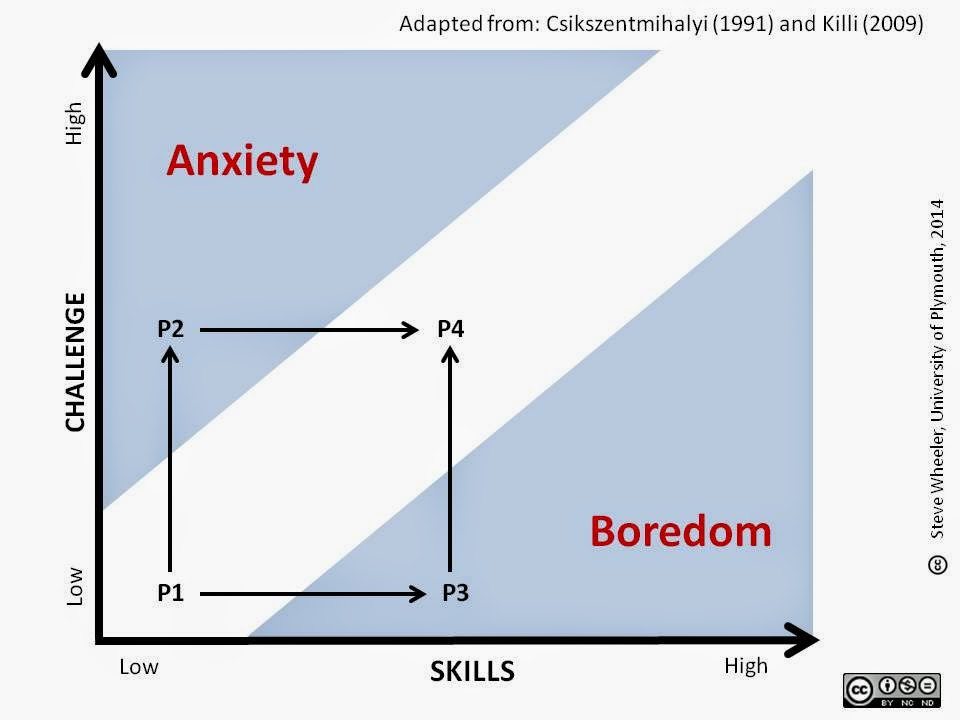A Primer On Flow Theory In The Classroom
contributed by Steve Wheeler, Associate Professor, Plymouth Institute of Education
This is number 6 in my blog series on major learning theories. My plan is to work through the alphabet of psychologists and provide a brief overview of their theories, and how each can be applied in education. In the last post we examined the work of Craik and Lockhart on Levels of Processing theory. In this post, we explore the work of Mihály Csíkszentmihályi on Flow Theory. This is a simplified interpretation of the theory, so if you wish to learn more, please refer to the original work of the theorist.
There is an interesting news report on the BBC News website this morning. It is a piece claiming that children who use technology at home are finding that they are not able to concentrate in school. They are not able to focus, claims the report, because ‘they’re spending so much time on digital games or social media.’ Yeah right. It’s easy to blame lack of concentration on technology, but what about the quality of the lessons they are attending?
The onus is on teachers to make lessons more interesting, and that is what they are trained to do. Part of the solution might be to incorporate these digital games and social media into some of the lessons. Just how can we engage students more effectively? Here’s Flow Theory:
The Flow Theory
You know that moment when you are in the zone, on the ball, completely focused? You become so absorbed by what you are doing that you forget what the time is, you forget to eat, you miss sleep. That’s essentially what flow is. According to Mihály Csíkszentmihályi, being in the flow is the ultimate in focused intrinsic motivation.
In simplistic terms, being in the flow is where students find themselves in that narrow channel between disinterest and fear. There is a fine balance between the challenge of the task, and the skills the learner has at their disposal. Maintaining this balance avoids disillusionment if your skills don’t measure up to the challenge, or boredom if the task is too simple and easy to achieve.
Learners who are immersed in their studies tend to be single-mindedly motivated to explore their topic. Getting them to the place where they fall so in love with learning that little else matters is another matter entirely. One of the ways teachers can help students to focus more on their studies is to make learning so irresistible that there is seems to be no other option.
Games and gamification may offer students the fine equilibrium between boredom and anxiety, as will other forms of immersive learning such as role play, simulation and problem solving. As long as the learning resource is designed to have the appropriate levels of challenge built into it, students will be interested. The graphic illustrates this clearly. P2 and P3 are positions that should be traversed quickly if students are to remain in the flow. (See also our post on Why We Play Video Games.)
To be successful, challenge-based learning requires achievable goals that require some incremental development of skills beyond the average, and where the challenge rises commensurately to match those skills (student progresses from P1 to P4). If the subject matter is made interesting and enjoyable enough, teachers won’t have to work too hard to encourage students to actively engage.
They will do so naturally, because they will want to rise to the challenge, and succeed because they see no other possible outcome.
Reference
Csíkszentmihályi, M. (1990) Flow: The psychology of optimal experience. London: Harper and Row.
Previous posts in this series:
Anderson ACT-R Cognitive Architecture
Argyris Double Loop Learning
Bandura Social Learning Theory
Bruner Scaffolding Theory
Craik and Lockhart Levels of Processing
This post first appeared on Steve’s personal blog; image attribution the man himself (Steve Wheeler); The Flow Theory In The Classroom: A Primer
